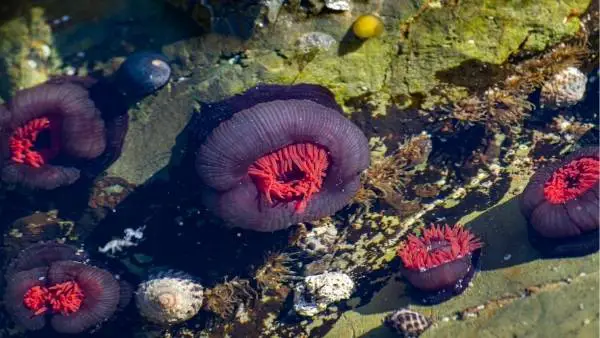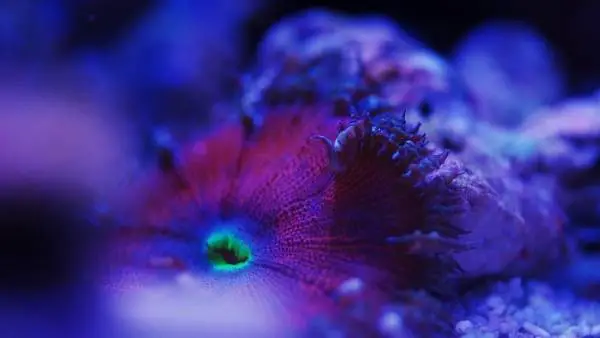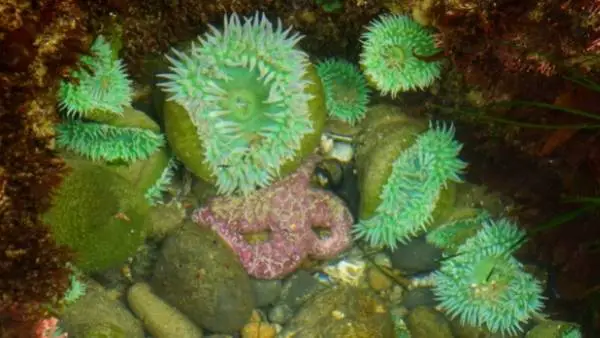Saltwater aquarium hobbyists are constantly looking to develop their tanks, adding new lifeforms in the way of fish, live rock, coral, and plants. Not only does this give your tank a fresh look, but it keeps the pre-existing inhabitants stimulated and happy. Obviously, you should take precautions with whatever you introduce to an established community to avoid hitchhiker critters, and non-compatible fish.

In this guide we will be running through everything there is to know about the Rock Flower Anemone, which is one of the most popular additions to any saltwater tank when discussing corals and anemones.
The Rock Flower has been named by many aquarists as the Flower Anemone, and also Speckled Rock Anemone, Banded Anemone, and Beaded Anemone. The scientific name for this specific anemone species is Phymanthus genus.
They are great additions to any reef tank; they do not move around the tank as much as other anemones which is a good characteristic.
Anemones have a reputation for moving around the tank, destroying pretty much anything in their way as they progress, even on rare occasions getting into important tank equipment like powerheads and literally ruining an entire tank setup!
Rock Flower Anemone General Information and Tips
The biggest draw with these anemones is that they do not move around fish tanks – once they are totally settled within your tank, they will typically stay in one position the whole time, barely moving, and barely causing trouble.
Let’s take a look at the general information and requirements you as a hobbyist should know about before acquiring a rock flower anemone.
Appearance & Origins
These anemones originate from the Caribbean, and they are readily available in an abundance of awesome colors. Colors range from red, blue, green, purple, orange, tan, and much more, they will certainly brighten up your aquarium! You can easily create an incredible array of colors in your tank from these anemones if you purchase them separately colored.
They are generally calm and well-natured meaning that they can be kept both individually and in groups. If you want to purchase several different colored anemones, then be prepared for a beautifully colored underwater anemone garden!
How Big do Rock Flower Anemones Get?
Rock flower anemones will typically bury the majority of their bodies, leaving only their oral disk and tentacles exposed. These anemones tend to stay still most of the time, which is different to most of their anemone counterparts, and they will grow to roughly 6 inches (15 cm), with some even reaching 8 inches (20 cm) in length giving the anemone somewhat of a flowery appearance.
Rock Flower Anemone Placement
The Rock Flowers ideally like being placed on either rock walls underneath some shade, or in the sand bed. If you decide to place them in the substrate, then they will likely bury their bodies and leave only their disk and tentacles on display. Once they are placed and settled within your tank, they will hardly move anywhere. They do tend to enjoy and thrive off living on vertical rock walls, so if you have one with space on it, place them there.
Are Rock Flower Anemones Hardy?
Yes, fortuantely rock flower anemones are incredibly hardy anemones, and will adjust to water parameter changes within your fish tank without any issues. Their hardy nature and low maintanance makes them a perfect anemone for beginner hobbyists who want to experiment with live corals and plants.

Rock Flower Anemone Setup and Water Requirements
Just because they are technically plants it does not mean that they do not require as much effort in their tank setup as regular saltwater fish do.
Water Parameters
In order for your anemones to remain healthy and happy, you should follow these parameters:
- The pH level should be 8.1 to 8.14.
- The alkaline level should be: 8 to 12 DKH.
- The calcium should be at 400 to 450 PPM.
- Magnesium needs to be at 1250 to 1350 PPM.
- Water temperature should be 72°F to 78°F (22°C to 25°C).
Lighting Requirements
These anemones will adapt to many different lighting conditions as long as it isn’t too bright. They will do well in low to medium light ranges. You ideally want a PAR (PAR is a measurement of light) rating between 50 to 150 for them to thrive, 100 is the ideal PAR rating.
If you own SPS corals before you have added these anemones and your light is at a high rating, then simply keep the anemones low in your tank and preferably as far away from your tanks light source as possible.
Waterflow Requirements
The Rock Flower Anemone prefers a medium water flow in the tank they reside in, you can even go high with it – they will accept that too. These anemones love water movement, and even though they can adapt to a multitude of different parameters, you still want the waterflow to not be too high, nor too low. The best recommendation would be a medium flow with a varied pattern of how the water flows too.
Acclimation
When it comes to acclimating anemones, it is pretty much the same process as with fish. You must take your time and be extremely careful when performing this crucial process. The stresses of moving and shipping will mean that your new addition will need time to acclimate to your aquarium. Drip acclimation is the best bet, 30 minutes to an hour of drip acclimation will give the anemone time to adjust to its new environment.
Do I need to Feed my Rock Anemone?
Yes, they are carnivores and will certainly require meaty food, the best diet for them is a mixture of shrimp, fish meat, and frozen foods. Make sure you cut the food into small pieces for the anemone to eat and digest them, remember, they aren’t a fish! Regular feeding will help them grow strong and healthy, with any fish or anemone, the healthier they are, the brighter and more vibrant they will look.
Frequently Asked Questions (FAQs)
Here are some of the most commonly asked questions when it comes to these beautiful yet incredibly unique anemones.
Why is my Rock Flowe Anemone not Opening?
There are tons of valid reasons as to why your rock flower anemone is not opening, and you should only intervene as a last resort after giving your anemone some time to open back up. They typically close up when eating and may not open back up for a number of hours, they also close up when on the move, it is not common for them to be moving around your tank, but still a possibility. The final reason your anemone might not be opening is that it is injured or dying, if your rock anemone has not opened in some days, take it to the nearest veterinary and explain the situation and behavior of your pet.
Are They Clownfish Compatible?
Unfortunately, and rather oddly, rock flower anemones are not compatible with clownfish. In fact, despite their generally calm nature, they can sting and or eat the fish! The Rock Flowers will not host Clownfish, however, the Bubble Tip and Carpet Anemones will certainly host them.
Fortunately, clownfish do not need anemones to survive, so, you will not need to desperately find an anemone for your clownfish tank, should you choose to acquire one. They will, however, host critters such as anemone crabs, sexy shrimp, and anemone shrimp.
Are Rock Flower Anemones Aggressive?
It is not common for them to be aggressive, however, on occasion the Rock Flower Anemones can and will eat fish. If a fish gets too close or tries to steal the food of the anemone (generally annoying the anemone), then the anemone can sting and eat it. There are mixed reviews regarding their eating habits.

Do Rock Flower Anemones Eat Fish?
Generally not, but some hobbyists have said that they do eat other fish, whilst others say that they don’t and go about their business in a peaceful manner. It seems as though it can go either way, but with all anemones there is a risk of this occurrence.
Conclusion
In conclusion, these anemones are a fantastic addition to any tank, especially for beginner hobbyists! They are hardy and can adapt to most conditions and aquariums, they also don’t move around very much which is a bonus.
They are not cheap, but certainly not too expensive either, and are fairly easy to source. It is important to understand that, with these anemones, they will not get along with your clownfish and will likely cause them pain and can eat them in some circumstances.
They are not particularly known for their aggressiveness, but they certainly can be, so be careful. Apart from that, they are brilliant anemones and will make for a bright and colorful addition to your reef aquarium.

